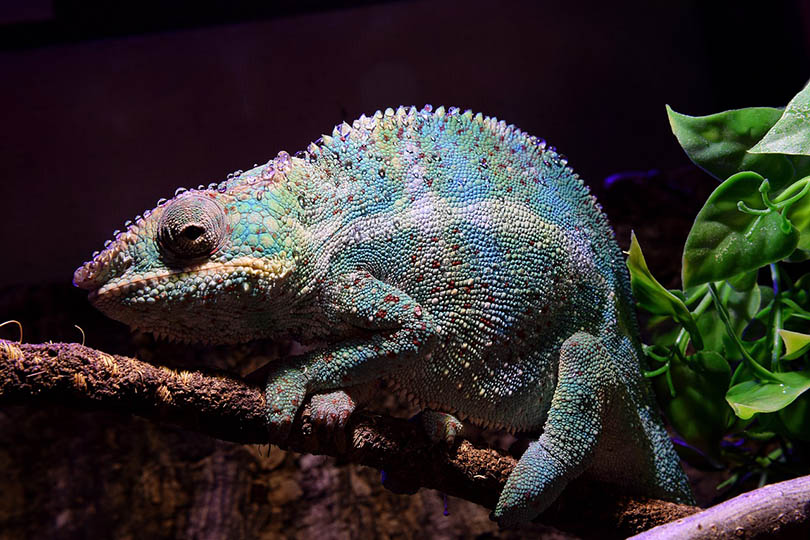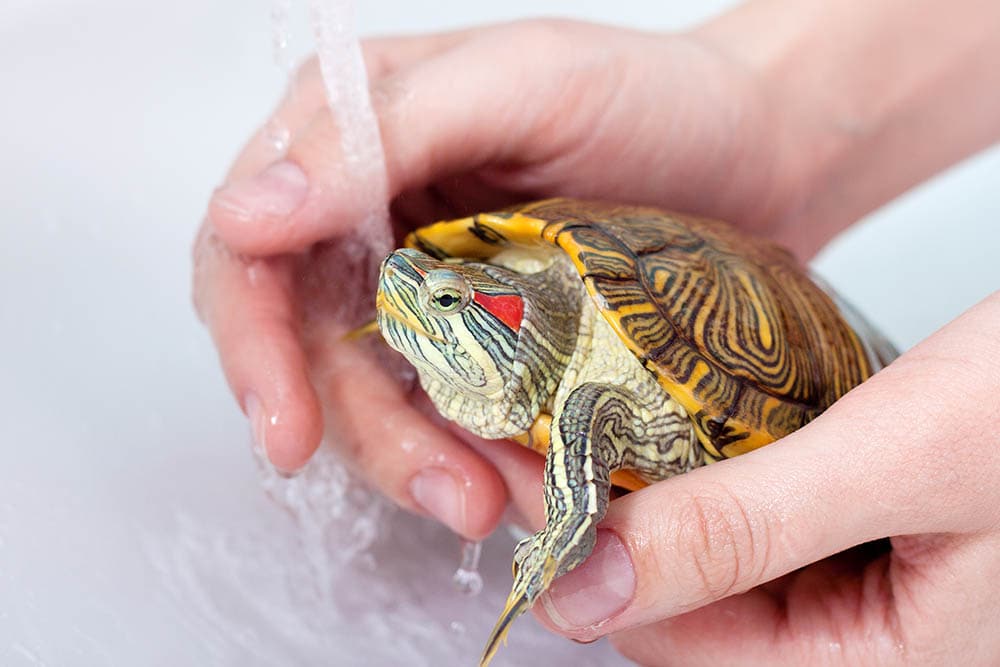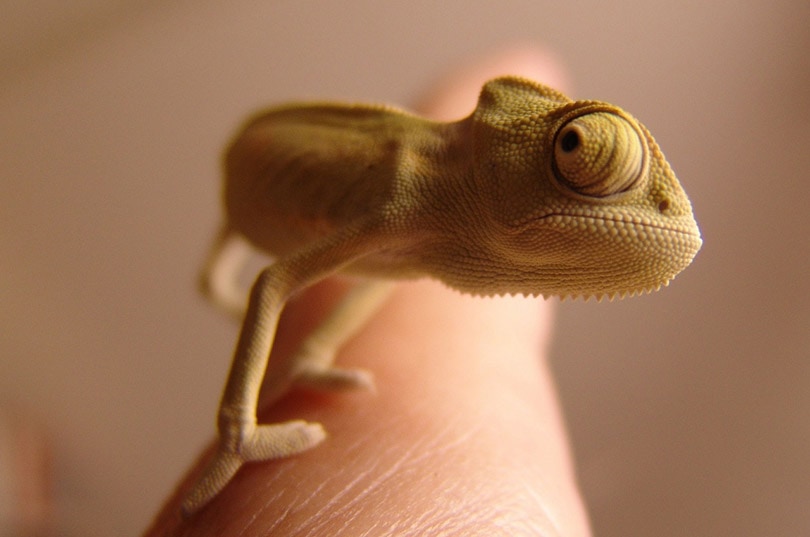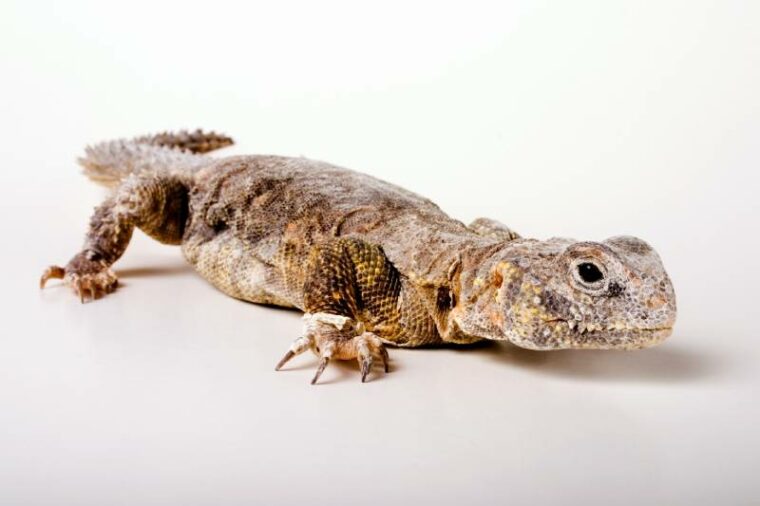
Click to Skip Ahead
The Uromastyx, or Spiny-Tailed Lizard is a species of lizard that comes from Africa and Asia, where it lives in very hot climates. The Mali Uromastyx specifically comes from Mali, in western Africa. The species is well adapted to life in the desert. It can go several weeks without water, is an herbivore, and males tend to be black with yellow markings, although females are a plain brown or tan color.
Like all Uromastyx, the Mali Uromastyx is a docile lizard that will tolerate handling and can become quite tame with regular handling. The most difficult aspect of owning this lizard is meeting its high heat requirements and ensuring that they have suitable basking spots.
Mali Uromastyx Overview
| Species Name: | Uromastyx maliensis |
| Common Name: | Mali Uromastyx |
| Care Level: | Moderate |
| Lifespan: | 15 years |
| Adult Size: | 12 – 16 inches |
| Diet: | Primarily herbivore |
| Minimum Tank Size: | 40 gallons |
| Temperature & Humidity | 80°F – 110°F |
Do Mali Uromastyx Make Good Pets?
Mali Uromastyx are tolerant of handling and can become quite placid when handled regularly. They rarely bite, and their diet is primarily herbivorous, which means there is rarely any need to feed crickets or mealworms, something which can put potential owners off.
However, they do need good care levels, which includes making sure they have a suitable habitat. A 40-gallon tank should be considered the bare minimum, and this does take up a fair amount of space. The Uromastyx needs a basking spot with temperatures as high as 100°F to 120°F as well as plenty of UV light to simulate the bright sun they would experience in their natural desert habitat; there are some high care requirements.
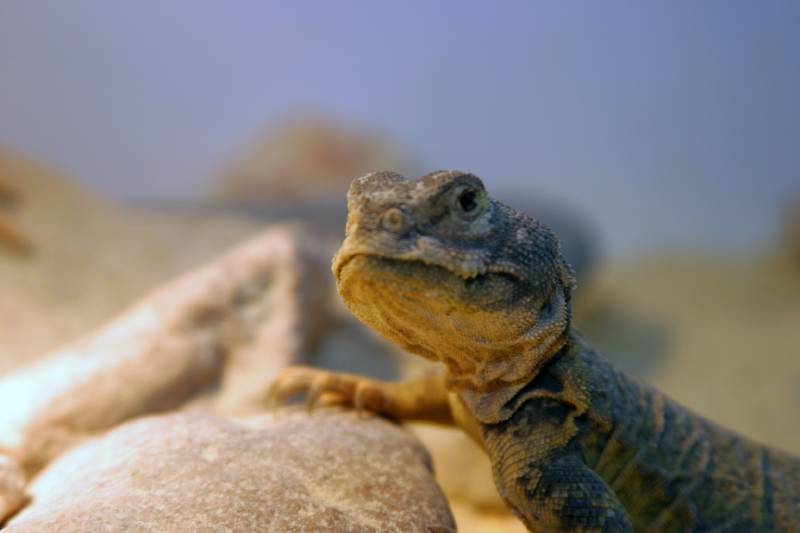
Appearance
Uromastyx are also known as Spiny-Tailed Lizards because they have sharp-looking spines on their tails. The appearance of the species does vary according to the exact breed. A male Mali Uromastyx is usually dark black with yellow markings. The female will usually be a brown or beige color. Males grow to approximately 16 inches, while females will grow to 12 to 14 inches.
How to Take Care of Mali Uromastyx
Habitat, Tank Conditions, & Setup
Uromastyx live in hot conditions, typically in desert habitats. To ensure a Uromastyx is healthy and happy, you need to emulate the conditions they would experience in the wild, as closely as possible while also providing enough space and enrichment.
Tank
An adult Uromastyx should be given at least a 40-gallon tank. In terms of space, there is no such thing as too big a tank. However, bear in mind that you do need to keep temperatures high and the larger the tank, the more difficult and the more costly this will prove. Uromastyx are mainly terrestrial which means they need vertical space over horizontal space, with typical dimensions being 4 feet long by 1 foot deep and 1 foot tall.
You do need to ensure that the tank is kept clean, which will mean spot cleaning whenever you see solids or clumped substrate, and deep cleaning the tank and its contents weekly.
Lighting
Because the Mali Uromastyx comes from desert regions, it does require a lot of light to emulate the natural sunlight of the desert. Poor lighting can lead to metabolic bone disease. A full spectrum UV light is important, typically provided by a UVB fluorescent light or a mercury vapor light bulb. At night, the light should be turned off to simulate a proper day/night cycle. This is best achieved using a digital timer to make sure you don’t forget to turn the light on or off.
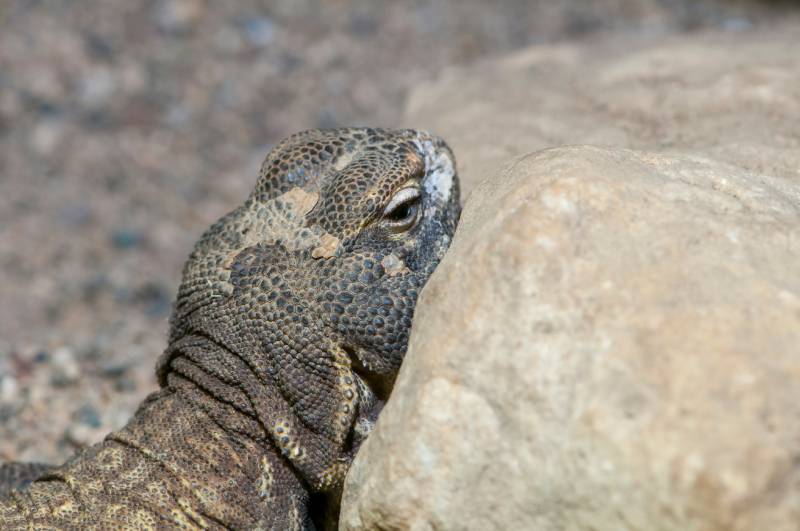
Heating
The species also requires a lot of heat, ideally with a gradient of heat across the tank. The cooler end of the tank should be around 80°F although it can drop to high 70s. The hot end should be around 100°F with a basking spot temperature as high as 120°F. Younger Uromastyx should have slightly lower temperatures. The temperature should be kept to at least 70°F at night.
Substrate
The Uromastyx does hail from the desert so many owners use sand as a substrate in the tank. However, young Uromastyx can eat some of the sand while feeding which can cause impaction. Aspen chips are less likely to be ingested and are easier to keep clean, so this is a highly recommended substrate option.
| Tank Recommendations | |
| Tank Type | 40-gallon glass vivarium |
| Lighting | Full-spectrum UV lighting |
| Heating | 100°F+ |
| Best Substrate | Aspen bedding |
Feeding Your Mali Uromastyx
The Mali Uromastyx is primarily herbivorous. Feed leafy greens as well as peas and seeds. Leafy green options include collard greens, kale, and mustard greens. You can also feed a small amount of carrots and squash. It is good to feed a variety of foods and to change the primary foods you give to keep interest up and prevent food boredom. You can occasionally give a cricket or mealworm as a treat, but this should only be occasional. Dust all food with a supplement that contains calcium and vitamin D3.
| Diet Summary | |
| Fruits | 0% of diet |
| Vegetables | 100% of diet |
| Insects | Occasional treat |
| Meat | 0% of diet |
| Supplements Required | Calcium/Vitamin D3 |
Keeping Your Mali Uromastyx Healthy
Ensure you provide a high enough temperature and plenty of UV light. Failing to do so can lead to serious illness, especially for Uromastyx because they would naturally have very high levels of both. You also need to feed a suitable diet consisting primarily of leafy greens. You may feed the occasional insect treat.
Lifespan
Generally, a healthy Uromastyx kept in good conditions and given an appropriate diet can live up to 15 years or potentially even longer. Most live around 12 years.
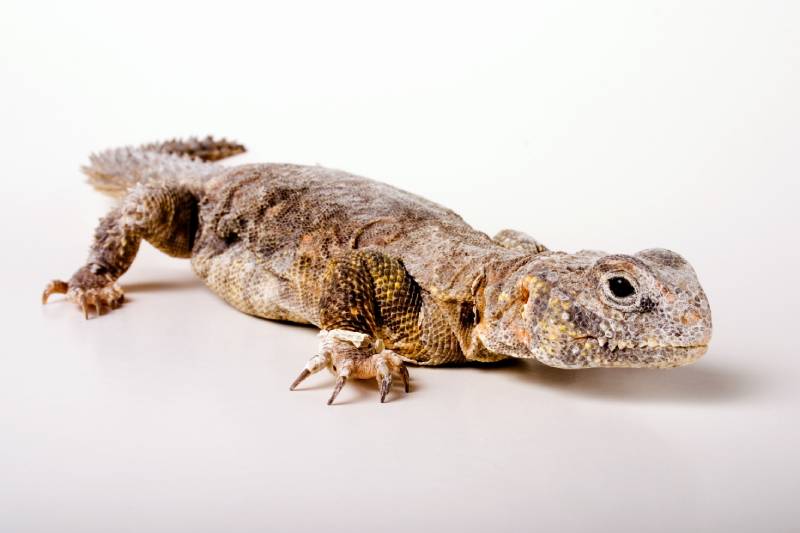
Breeding
Uromastyx mating is quite violent and is not generally recommended for novice breeders. Unless you have homes for the young, it is also not recommended that you breed the species because they can be difficult to sell to pet shops and suppliers, and you will need a lot of tanks and space if you do have a clutch of eggs.
Males tend to be more colorful than females, but the colors can take time to develop so it can be difficult to sex young lizards. Breeding most commonly occurs after brumation. The male will bite the back of the female’s neck and may pull her around the tank during mating. Around 6 weeks after mating, the female will lay a clutch consisting of between 4 to 20 eggs. The eggs usually hatch within 70 days.
Are Mali Uromastyx Friendly? Our Handling Advice
Mali Uromastyx are considered friendly lizards that tolerate handling. However, if you want to ensure that you do have a tolerant lizard, you should start handling them when they are young and make sure you handle them every day. Avoid dropping or otherwise scaring the lizard, or it will set your efforts back. And, because the Uromastyx needs such high temperatures, you should keep handling time out of the cage to short sessions.
Shedding & Brumation: What to Expect
Uromastyx shed and brumate in the wild. All lizards shed their skin as they outgrow their old skin, and also regularly to replace damaged skin. Expect adults to shed once or twice a year with younger examples shedding every few weeks to every couple of months. Brumation occurs naturally in the wild, and the Uromastyx will slow its heart rate and not need to eat for several months. Your pet Uromastyx may or may not brumate—it is usually dependent on ambient temperature.
How Much Do Mali Uromastyx Cost?
Mali Uromastyx are more expensive than some of the more common species, and more expensive than other beginner lizards like Bearded Dragons. You can pay between $150 and $250 for a medium to large adult.
Care Guide Summary
| Mali Uromastyx Pros | Mali Uromastyx Cons |
| Don’t need to be fed live insects | Quite expensive compared to other species |
| Tolerant of handling | Need high temperature and low humidity |
| Fairly easy to look after |
Conclusion
The Mali Uromastyx is a species of Uromastyx that, in the wild, lives in a desert environment. It needs a lot of heat and low humidity but is primarily herbivorous and tolerant of handling, which makes it a popular choice as a pet lizard. It is more expensive than most Bearded Dragons and some other species of Uromastyx, but the black and yellow color of the male makes it a popular option.
Provide at least a 40-gallon tank and be prepared to offer a lot of heating to ensure your lizard stays healthy and happy.
Featured Image Credit: Michelle D. Milliman, Shutterstock



